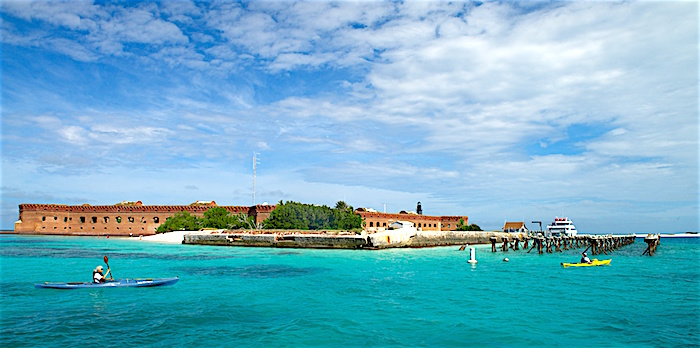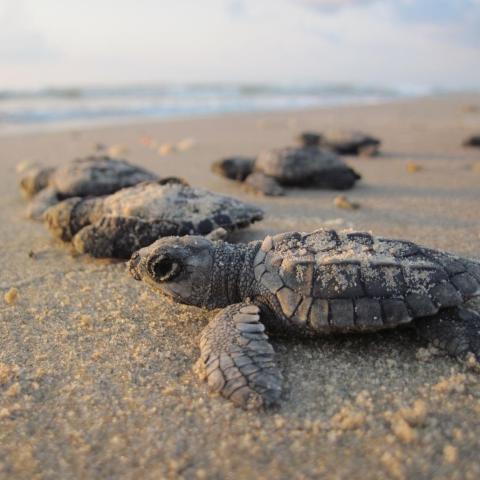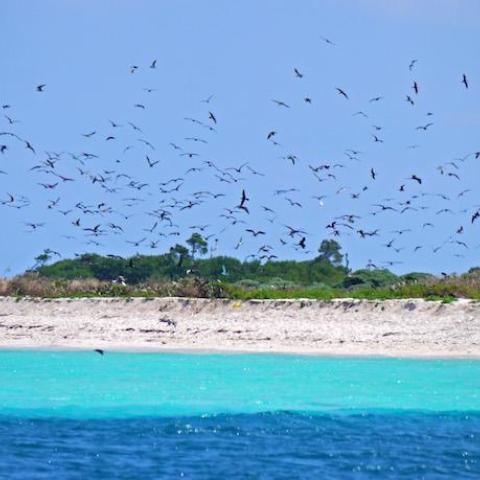Editor's note: The following is advertiser-supported content from Traveler's Essential Park Guide, Summer 2017.
Located 70 miles west of Key West, Florida, Dry Tortugas National Park is one of the most remote national parks in the United States. Visitors can only access the park via boat, seaplane, or aboard the official Dry Tortugas National Park ferry, the Yankee Freedom III. As a result, the park boasts some unusual facts that not all park travelers might know.
Dry Tortugas National Park
1. Known for its spectacular reefs and marine life, Dry Tortugas National Park encompasses a seven-island archipelago. The explorer Ponce de Leon was the first European on the islands, situated in the Gulf of Mexico, during his fabled quest for the elusive fountain of youth. The abundant sea turtle population inspired the name Las Tortugas, and the scarcity of fresh water prompted the Dry Tortugas designation. In 1822 the area was annexed by the United States and, 24 years later, the Navy began building a fort to protect the Florida coastline. Although the garrison was never finished, it remains an iconic symbol of the national park.
2. President Franklin Roosevelt created Fort Jefferson National Monument in 1935, which was expanded 48 years later to protect the islands and their surrounding marine habitats. In 1992, the conservation area was renamed Dry Tortugas National Park. It is renowned for its shipwrecks, sunken treasure, and Civil Warera fort, as well as its pristine water, abundant sea life, and tropical bird breeding grounds. Open year-round, the national park is a unique combination of exotic habitats and historic artifacts that attract more than 80,000 people annually. In addition to scuba diving and snorkeling, visitors can swim, bird watch, saltwater fish and picnic.
3. The area possesses one of the richest concentrations of shipwrecks in North America. Nearly 200 ships sank in the surrounding waters before and shortly after the construction of the Garden Key Lighthouse in 1825. These include several vessels from the famed Spanish gold convoy of 1622, such as the Buen Jesus y Nuestra Senora del Rosario. Submerged artifacts include anchors, cannons, pottery, and other maritime items.
4. Because of the long history of shipwrecks, the Dry Tortugas is home to two of the most historic lighthouses in Florida. Built in 1826, the Garden Key Lighthouse was the first in the Dry Tortugas and stands 65 feet tall. After continued shipwrecks, a second, larger lighthouse was illuminated in 1858. It stands 150 feet tall and is located 3 miles to the west on Loggerhead Key.

The waters of Dry Tortugas National Park contain wonders only snorkelers and scuba divers see/NPS
5. Covering 67,400 acres, the national park is 99 percent water. Totaling approximately 100 acres, the seven main islands comprise just 1 percent of the park. The islands are Loggerhead, Garden, Bush, Long and Hospital keys, as well as the East and Middle keys. While the shape of the remaining islands perpetually changes, tidal erosion has submerged four islets, including Southwest, Bird, North and Northeast keys. The park is part of the UNESCO Man and Biosphere Program that also includes the Everglades.
6. For three decades, marauding bandits used turtle eggs and adult turtle meat as currency. One of these buccaneers was Jean Lafitte, the pirate who aided General Jackson in the defense of New Orleans. The American naval base was the last stop before the ill-fated USS Maine sailed to Havana Harbor in 1898.
Ecosystem
1. The Dry Tortugas feature a borderline subtropical/tropical ecosystem that hosts numerous rare, endangered, and endemic species that do not normally breed anywhere else in the United States.
2. The park’s colorful coral reefs are home to barracudas, sharks and wahoos, as well as lobsters, sponges, and sea anemones. The regal coral of this majestic marine sanctuary is easily accessible from the white sand beach near Fort Jefferson.
3. Over 200 avian species migrate through the park each year and it’s not uncommon to see 70 species in one day during peak migration. Flamingos, warblers, nighthawks, owls, terns, falcons, pelicans, and cuckoos are some of the families of birds you might see.
4. During peak nesting, there can be 100,000 sooty terns on Bush Key all at once. In addition to the sooty tern, some other commonly observed birds at the Dry Tortugas include the brown noddy, black noddy, magnificent frigatebird, and masked booby.
5. Dry Tortugas National Park is the most productive nesting region for the green and loggerhead turtles in the entire Florida Keys. Five different species of sea turtles in the Florida Keys are listed on the Endangered Species Act.
Fort Jefferson
1. Situated on Garden Key, the fort is one of the largest masonry structures in the Western Hemisphere. Named after Thomas Jefferson, the bastion housed 25-ton Rodman cannons, rifled Parrott guns, and several hundred other pieces of heavy artillery. The fort, which remained in Union hands during the Civil War, never fired a shot during combat. It was constructed of 16 million bricks over three decades. During its peak occupancy in the early 1860s Fort Jefferson housed almost 2,000 soldiers and civilians.
2. Captain Montgomery Meigs drew up the plans for Fort Jefferson that included the existing Garden Key Lighthouse and keeper’s quarters. Rising through the ranks, General Meigs was instrumental in creating Arlington National Cemetery during the Civil War. In addition to civilian carpenters, masons, and other skilled laborers, the fort also used African-American slaves from Key West during construction. The black workers on the island were freed after the Emancipation Proclamation.

A stopping point for many migratory species, Dry Tortugas is a bird lover’s destination/Yankee Freedom III
3. Dr. Samuel Mudd was the most famous prisoner at Fort Jefferson and was sentenced to life imprisonment for his role in helping John Wilkes Booth during the assassination of President Abraham Lincoln. Dr. Mudd was granted a pardon from the prison in 1869 after only serving about four years because he was instrumental in helping the Fort recover from a yellow fever epidemic in 1867.
4. During a tropical storm, Ernest Hemingway and a group of friends were stranded at Fort Jefferson for 17 days with only a short supply of canned goods, liquor, coffee, and the fish they caught from the ocean.
To learn more interesting facts about Dry Tortugas National Park or find information about booking a day trip from Key West aboard the Yankee Freedom III, please visit www.drytortugas.com.






 Support Essential Coverage of Essential Places
Support Essential Coverage of Essential Places







Comments
We just love the Dry Tortugas the water is beautiful and clear the history is rich and the sun shines bright we've been twice by sea plane
Sure hope Ft. Jefferson fares well after Irma!
VERY helpful